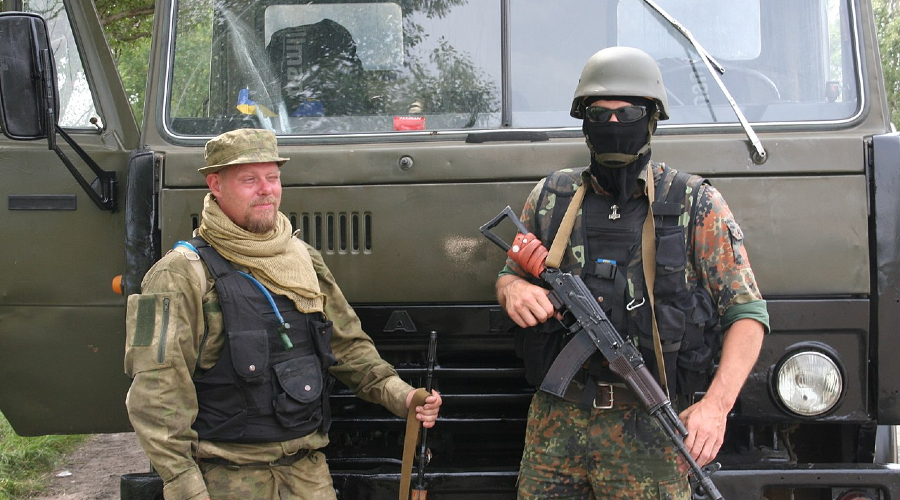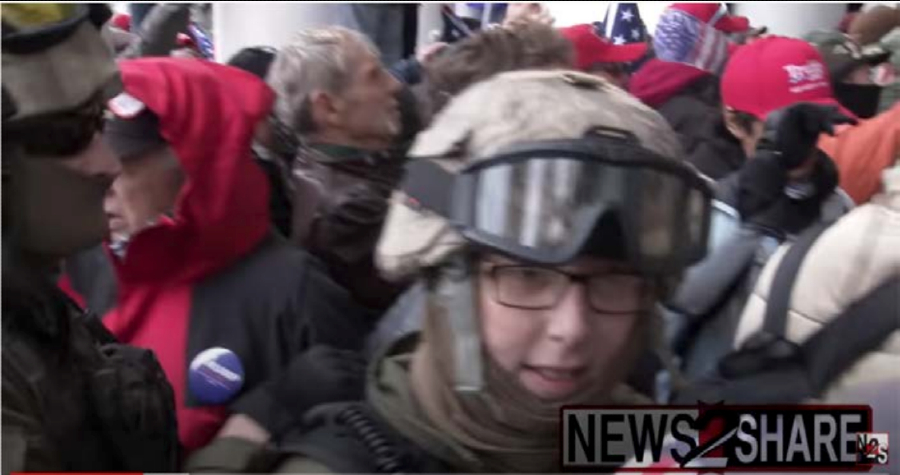The International Far-Right Terrorist Threat Requires a Multilateral Response
Tools developed to combat terrorist financing over the past two decades can be adapted to the growing transnational threat.

Editor’s Note: Right-wing terrorism is a problem around the world, and international connections within the movement are growing. Although the Biden administration promises to step up efforts to fight this danger, most of the efforts are concentrated at home. Jason Blazakis and Naureen Chowdhury Fink of the Soufan Center present lessons from past efforts to fight terrorism globally and offer ways to use international organizations and action abroad to fight right-wing terrorism at home.
Daniel Byman
***
Right-wing violence is a global phenomenon. The United Nations Counter-Terrorism Committee Executive Directorate (CTED) illuminated this global challenge in 2020 when it issued an alert that cited “a 320% increase in terrorist attacks by groups or individuals affiliated” with right-wing extremism. A U.S.-only focus to countering far-right terrorism will not curb this growing threat to international peace and stability. Though there are challenges to organizing a multilateral response, the United States, the United Nations, and other partners have tools available that they can adapt from efforts to disrupt the financing and organization of jihadist terrorist groups.
American and international far-right groups do not carry out their misdeeds in isolation. A 2019 report by the Soufan Center (where we both work) singled out Ukraine as an epicenter of organizing; white supremacists, including more than 30 Americans, have traveled to the country to hone their skills with Ukrainian-based neo-Nazi groups like the Azov battalion, which has been fighting Russian separatists. In October 2020, two Americans from the Atomwaffen Division (AWD), a U.S-based neo-Nazi group, tried to link up with the Azov battalion in Ukraine so that they could gain combat experience. Propaganda and ideological concepts were shared between members of the American radical right and like-minded individuals overseas via fascist websites. AWD used the fascist web forum Iron March to connect with European-based neo-Nazi groups like the Nordic Resistance Movement.
The interaction between U.S. and global far-right figures and entities goes beyond propaganda and training-related activities. It also includes operational encouragement and financing. In 2019, a 13-year-old Estonian national associated with the Feuerkreig Division was linked to U.S.-based white supremacist Conor Climo’s plot to attack a Las Vegas synagogue. A teenager in the United Kingdom was also convicted for terrorism offenses, having led the British arm of the Feuerkrieg Division and indicating interest in “White Jihad.” Reports suggest he was in touch with the teenager in Estonia. The Vegas plot was thwarted, but other far-right terrorist attacks in the United States have been carried out. In the aftermath of the Jan. 6 attack on the U.S. Capitol, Chainalysis, a blockchain analysis firm, determined that more than $500,000 of Bitcoin was transferred from a far-right French citizen to Nick Fuentes, a white nationalist who breached the Capitol during the Jan. 6 insurrection. The cases of Climo and Fuentes illustrate the dangers of extreme right-wing interaction across geographic borders.
The international community’s efforts to curb al-Qaeda and the Islamic State’s actions provide an important guide as policymakers, the private sector and civil society actors consider steps to counter this ascendant far-right challenge. After 9/11, the U.N. Security Council accelerated efforts to sanction (via the U.N. 1267 Sanctions Committee) individuals and groups associated with al-Qaeda and worked with governments to strengthen their legal and policy frameworks to counter terrorist financing. These sanctions, implemented by the nearly 190 member nations of the United Nations, imposed a worldwide asset freeze, arms embargo and travel ban against those listed. These measures have produced ongoing successes in countering terrorist groups. The U.N. 1267 Committee’s Monitoring Team’s latest report cites the seizure of assets from U.N.-listed terrorist organizations Jemaah Islamiyah and Jamaah Ansharut Daulah in Indonesia in late 2020 following a series of arrests. According to the U.S. Department of the Treasury, by the end of 2019, more than $4 million worth of al-Qaeda-linked assets, including funds supporting affiliates like al-Shabaab and al-Qaeda in the Arabian Peninsula, have been blocked in the United States pursuant to international obligations. This sanctions regime was especially important when the Islamic State gained control of a record amount of assets—they raised approximately $2 billion in 2014 alone but were constrained in their ability to transfer or spend these assets. The Security Council also adopted a broad framework of binding international legal counterterrorism obligations, which included measures designed to strengthen legal and criminal justice measures and counter terrorist financing, and established the UN Counter-Terrorism Executive Directorate (CTED) to help states ensure their domestic legal, policy and practical measures met these obligations. While these efforts have been tailored primarily to counter the threats posed by the Islamic State and al-Qaeda, CTED is also well positioned to do the same for countries struggling to counter the global far-right.
In addition to the United Nations’s efforts, the Financial Action Task Force (FATF), an intergovernmental body focused on countering money laundering and terrorist financing, has played a role in countering extremist financing. In 2015, the FATF published a detailed typology report on the Islamic State’s financing that provided governments, the private sector and the nongovernmental organization community with unique insights into how the organization operates. The FATF, however, has been largely silent on the growing threat posed by far-right terrorist groups and their financing. Without official FATF guidance, banks are less knowledgeable about right-wing methods to accrue and move money.
Adapting International Counterterrorism Frameworks to the Far-Right Threat
There are four main challenges when considering the development of an international approach to countering the financing of far-right terrorism.
First, unlike al-Qaeda or the Islamic State, there is no single identifiable group of a similar scale in the far-right movement. In addition, both groups enjoyed relatively robust command and control at their peak, which the far-right does not. The far-right extremist movement remains diffuse, with individuals and several different groups accounting for extremist violence in the United States and abroad, and with no clear consensus on strategic objectives or organization.
Second, though severe attacks, like the 2019 shootings in Christchurch, New Zealand, have occurred, the scale and scope of far-right violence has not reached that of the attacks of September 11, 2001, or the subsequent attacks claimed by al-Qaeda and the Islamic State around the world. No state has invoked the role of the U.N. Security Council or proposed a Chapter VII resolution to establish a binding international legal framework on extreme far-right terrorism akin to Resolution 1373, which was adopted unanimously just days after the 9/11 attacks and imposed an unprecedented set of binding obligations on states that, as Eric Rosand has argued, closed existing gaps in the U.N. legal framework for counterterrorism. In the absence of a mass casualty attack on that scale, decisive action is difficult to mobilize. Given these challenges, it will be difficult to design an international sanctions regime for right-wing terrorism on par with the one designed for al-Qaeda and the Islamic State.
A third issue is that it is easier to take legal measures to address acts of terrorism that are linked to a designated foreign terrorist organization (FTO), but the United States, among other countries, currently has no means of designating domestic far-right extremist groups as terrorists. Moreover, there is currently no mechanism in U.S. law for designating a foreign terrorist entity on the basis that it has been so designated by another state. While the United States has often used multilateral tools to urge like-minded (and sometimes not) states to take domestic action against entities the United States believes pose a threat, there is at present no comparable mechanism for threats emanating from the United States. Discussions and briefings among researchers, policymakers, and U.N. experts in spring 2021 highlighted concerns that the locus of violent far-right extremism is moving from Europe to the United States and that, as it does, the value of domestic terrorism designations will take on greater importance to form a basis for international cooperation to counter the threat. This concern has been reinforced recently by experts urging greater attention to building alliances and international cooperation to counter far-right extremism.
Fourth, some governments have used counterterrorism measures and obligations as a premise for clamping down on human rights and civil liberties to suppress pluralism and dissent. This is less of a concern with the complex and heavily negotiated counterterrorism frameworks at the United Nations, which come with checks and balances. But as debates inevitably heat up regarding the pros and cons of domestic terrorism legislation in the United States, and its potential ramifications abroad, policymakers must be careful that measures to counter far-right extremist financing are not instrumentalized to perpetrate human rights abuses and achieve the very goals that serve the interests of violent far-right extremists.
Finally, before setting out new approaches to tackling the financing of international far-right extremism, it will be important to reflect on the lessons learned from the previous two decades. In terms of the counterterrorism sanctions regime under Resolution 1267, it was a success to get the designations on the books and get states to follow suit, so they are there to take further action and allow institutions to follow up. However, implementation in some states remains low. Additionally, institutional silos and disjointed policymaking, amid a range of other factors, has sometimes led to tensions between counterterrorism policies and other strategic objectives, like conflict resolution, peacekeeping and the provision of humanitarian assistance. As humanitarian expert Alice Debarre and others, like the Norwegian Refugee Council and Red Cross, have highlighted, there are widespread concerns that counterterrorism sanctions and measures have had a tremendously negative effect on legitimate humanitarian organizations, imperiling their ability to deliver critical assistance in complex conflict settings. Security Council Resolutions 2462 and 2482, adopted in 2019, were the first to reflect these concerns and take steps to rebalance the framework to reduce negative impacts. De-risking measures by the private sector, arising out of compliance obligations relating to counterterrorism sanctions, have also reportedly restricted access for civil society organizations, despite efforts by the FATF to revise their original presumption of risk for all nonprofit organizations. Efforts to tackle financing of far-right groups must not replicate these effects.
International Action to Address Far-Right Terrorism
These challenges do not preclude multilateral action to address transnational right-wing violence. First, more could be done through the United Nations and relevant international partners to strengthen international action. The binding framework established pursuant to Security Council Resolution 1373 and the subsequent establishment of the Counter-Terrorism Committee and the CTED, an expert body to support Security Council members in implementing policy, is not limited in scope to al-Qaeda and the Islamic State. The resolution and the CTED focus on preventing and suppressing the financing of terrorist acts more generally.
States could work through the CTED to develop a stronger monitoring capacity on international far-right financing and develop more tailored legal and policy responses, as they are already doing on broader counterterrorism compliance. Through such a mechanism, it could be possible for the United Nations and relevant international partners to work with each state to appropriately designate far-right terrorist groups in a domestic context and cooperate internationally to confront them.
The frameworks established to address the terrorist threat posed by al-Qaeda, the Islamic State and their affiliates can be adapted to manage far-right violence. The Financing Convention is another opportunity for multilateral action. The treaty requires state parties (of which there are currently 189, including the United States) to criminalize the financing of any terrorist act, not just jihadist ones. Additionally, there exist binding Security Council resolutions that apply to all forms of terrorism. Noting the volume of counterterrorism law adopted by the Security Council in recent years, legal expert David McKeever has argued that the focus should be on implementing what is already in place and that future council resolutions in this area should be informed more systematically by considerations of necessity and efficacy.
A second line of effort includes working through the established processes to designate FTOs or specially designated global terrorists (SDGTs). Currently, without domestic designations of terrorist groups in the United States, it can be challenging for law enforcement and financial institutions to identify and monitor suspicious activity related to the financing of domestic violent extremism. Moreover, the different requirements for material support offenses are currently linked to a designated FTO. The absence of such a designation, combined with constitutional protections of free speech, may make it more difficult for law enforcement and government actors in the United States to combat financing of these groups. Applying the FTO or SDGT designations to violent far-right extremists in the United States, where there are sufficient “foreign” aspects that meet the designation criteria of the group to warrant listing as an FTO or SDGT, would allow domestic and international actors to increase resources to targeting these extremists and improve consistency in classifying, investigating and prosecuting terrorist crimes, including financing or providing material support.
Third, as international actors like the United Nations, the Global Counterterrorism Forum, the FATF, and regional and subregional bodies grapple with questions of how to monitor and address funding to violent far-right extremists across the globe, it will be important to work with civil society groups and the private sector to strengthen research, guidance, and monitoring or mitigating capacities. Through the U.N.’s Global Research Network, the RESOLVE network, and academics and experts, greater research into the nuances and operations of various groups can help challenge their propaganda by showcasing contradictions and failures, and alert communities to the scale of the risk. At the same time, more research and understanding can help raise awareness and media literacy—online and offline—to prevent individuals from inadvertently supporting violence.
Countering far-right extremist violence will require a multilateral approach that mirrors the international nature of the threat. Attacks by far-right ideologues are increasing in frequency and prominence. However, there is no need to start from a blank slate, given the counterterrorism tools that have been developed over the past two decades, though they will require some fine-tuning. Policymakers should not wait for another mass casualty event to take action. It’s time to take the lessons learned from disrupting the financing of jihadist terrorism and terrorism prevention and apply them to the violent far-right extremist threat.






